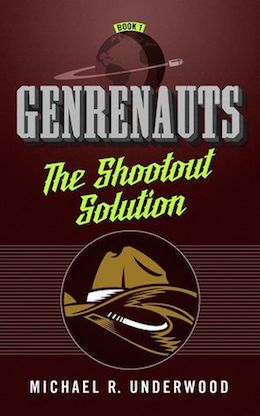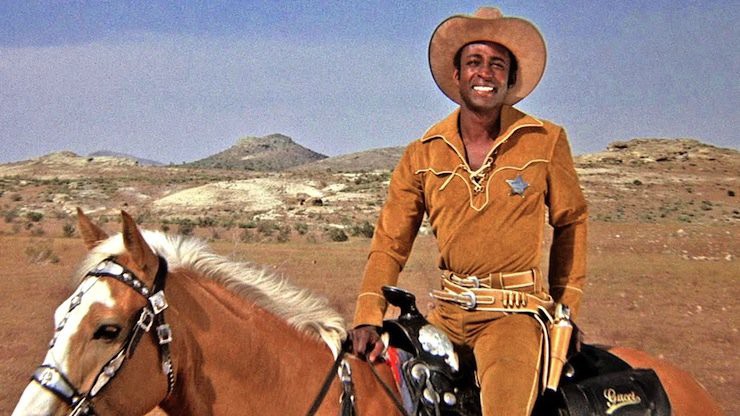When I was a kid, my bedtime stories for a good two years or so were Louis L’Amour’s Westerns Books on Tape (aka old-school audiobooks). I didn’t retain the details of the individual plots very well, nodding off between 10 and 30 minutes in, but what I did absorb was the aesthetic and the feel of the genre—the archetypes, the common stories—the lawman vs. the bandits, the prostitute with a heart of gold, the reluctant killer who has to take up the gun again to protect the town/their lover/etc., the lone hero struggling through the desert, the loyal deputy, the schoolmarm, and so on.
These days, Westerns mostly show up in hybrid form, combined with other genres—weird Western, Western SF, Western romance, etc. The familiarity of that genre brings recognizable but interesting contrasts with other genres, or uses other genres to invigorate the tale types and archetypes of the Western.
Which is exactly what I set out to do. By starting with a Western, I could count on the audience to get on-board with the set-up more easily, giving me room for complexity in other aspects (characterization and the overall setup of the series). And that led to the practical aspects of telling a post-modern Western for a 21st-century audience—an audience that wouldn’t take kindly to unselfconscious replication of the genre’s sexism and racism.

For inspiration, I turned to my favorite, loving parody of the Western genre—Blazing Saddles. The film tackles the racism of the period/genre, challenging expectations of what a Western hero acts like as well as what they look like with Cleavon Little as Sheriff Bart. The film shows the emotional consequences of being a gunfighter with Gene Wilder’s character Jim, but doesn’t then delve into the darkness, it brings the character back into the light. Madeline Kahn’s Lili Von Schtupp is a brilliant, self-motivated send-up/remix of dance hall Marlene Dietrich, and in the finale, the film’s zaniness rises to such a level that it doesn’t just break through the fourth wall, it knocks the whole thing down, the fight spilling out into the world around the production of the film. Blazing Saddles isn’t perfect, especially in terms of its homophobic punchlines, but I could learn from its lessons and build on them.
First off, I wanted to make sure that women and people of color played important roles in the story. I had a leg up there with my main cast, but I wanted the Western characters to show the diversity of the period of history that inspired the genre. And I also wanted to play with the tale types themselves, since Genrenauts is all about finding broken stories and getting them back on track. I decided to focus on the “who gets to be a hero” aspect of Westerns, providing some alternatives and exploring heroic motivation with different leading characters.
So much of genre is how each one comes with expectations—the common stories, the expected plot twists, the aesthetic checkboxes many readers bring to a story, looking for a fresh take on familiar stories. In Westerns, I knew readers would be looking for gunfights, shady saloons, working girls, muscled bartenders, dastardly black hats, rugged white hats, and sullied but strong anti-heroes caught in the middle.
 There’s great comfort in the familiar, in being just one step ahead or behind your heroes, seeing the twist coming or being caught unawares. I wanted to play with expectations in The Shootout Solution, giving readers the familiar with one hand and throwing curveballs with the other. Since my Western town was intentionally generic, I turned that aesthetic checklist into a feature wherever possible, using my POV lead to talk about all the places where this Western was like any other Western. And perhaps even more importantly, I gave her an attitude toward it—she relished the back-lot sound-studio feeling of the town. One thing I learned writing the Ree Reyes series was that pop culture references and shout-outs to the familiar matter more when they matter to the character—their passion or snark provides an emotional access point for the reader—and so, Leah Tang, my lead, needed to have a perspective on the bizarrely familiar world she was entering, in addition to caring about the story she and the team were trying to put back on course.
There’s great comfort in the familiar, in being just one step ahead or behind your heroes, seeing the twist coming or being caught unawares. I wanted to play with expectations in The Shootout Solution, giving readers the familiar with one hand and throwing curveballs with the other. Since my Western town was intentionally generic, I turned that aesthetic checklist into a feature wherever possible, using my POV lead to talk about all the places where this Western was like any other Western. And perhaps even more importantly, I gave her an attitude toward it—she relished the back-lot sound-studio feeling of the town. One thing I learned writing the Ree Reyes series was that pop culture references and shout-outs to the familiar matter more when they matter to the character—their passion or snark provides an emotional access point for the reader—and so, Leah Tang, my lead, needed to have a perspective on the bizarrely familiar world she was entering, in addition to caring about the story she and the team were trying to put back on course.
And then, against that backdrop of generic tropes and Leah’s responses, I designed the episodes guest stars to stand out—a sensitive aspirant chef who is truly a reluctant hero, and his highly capable sister, with secrets of her own. These characters let me make my points about the genre’s blind spots, its lies by omission, and more.
The Shootout Solution is just my first foray into genre exploration via storytelling in the Genrenauts series, but looking back on my youth, on decades of Westerns, remixed, deconstructed, or played straight, it’s not surprising that it’s where I’d want to turn to launch the series. I’ll be back to that nameless generic town—there’s plenty left to say about the Western and what its endurance as a narrative tradition says about American conceptions of our own past, about the use of violence, and our self-defining narrative of how the country was born. Our heroes rode off into the sunset, but there will always be another town, another crisis, another time when heroes are called upon to fight for the soul of the Wild West.
The Shootout Solution is available November 17th from Tor.com Publishing.
Read an excerpt from the novella here.
Michael Underwood has traveled the world, knows why Tybalt cancels out Capo Ferro, and rolls a mean d20. He is the author the several series: the comedic fantasy Ree Reyes series (Geekomancy, Celebromancy, Attack the Geek, Hexomancy), fantasy superhero novel Shield and Crocus, supernatural thriller The Younger Gods, and GENRENAUTS, a science fiction series in novellas. By day, he’s the North American Sales & Marketing Manager for Angry Robot Books. Mike lives in Baltimore with his wife and their ever-growing library. In his rapidly vanishing free time, he plays video games, geeks out on TV, and makes pizzas from scratch. He is a co-host on the Hugo-nominated Skiffy and Fanty Show.










